

40 Thoughts on 40 Years


I made what I thought was an innocent little post on Facebook earlier this week with a “How It Started/How It’s Going”-style meme photo, acknowledging my 40th anniversary in the employ of the NHRA, from May 24, 1982, until present (and counting).
Now, I'm not saying that staying at the same job for 40 years is a common occurrence these days, or that you could be there and still love it on Day 14,611 as you did on Day One, but I was overwhelmed by the response — thank you ALL so much for the kind words — and it got me thinking about all that’s happened not just to me but to the NHRA over those four decades. Many of the readers of this column were involved in the sport to some degree in 1982 and can visualize how much everything has changed. It’s certainly not my journey alone but one that so many of you also have taken.
On the occasion of my 30th anniversary, I wrote a column recapping all of the amazing things I’ve gotten to do while working for NHRA National Dragster, so I won’t potentially bore you with a rehash of that, but think a little bigger and broader and insightfully about the view out my window during the trip.
Because I’m celebrating 40 years, I thought I’d share roughly 40 observations and opinions.
NHRA HIGHLIGHTS
The NHRA that I joined in 1982 had already been going strong for more than 30 years, and while there had been all manner of advancements and improvements since 1951, I look back at it through today’s eyes and see how very far we still had to go. A lot of really good things began to happen in the 1980s that helped propel the sport forward.
“Ballpark” strips: Dallas Gardner took over as NHRA President from Wally Parks not long after I arrived (1984) and mapped a vision of the future that included better facilities and better television (you can read the original manifesto here). While NHRA already had been on television for a number of years, first through Wide World of Sports and then through the Diamond P years, making technological and storytelling advancements, our national event tracks still left a lot to be desired. Although there had been exceptions (Dallas Int’l Motor Speedway, Ontario Motor Speedway, and Orange County Int’l Raceway being the best examples, but they were all already gone by 1984), seating was mostly in plain bleachers, and there was nowhere for teams or the NHRA to court sponsors in comfort (i.e., VIP suites), and scoreboards were virtually nonexistent.
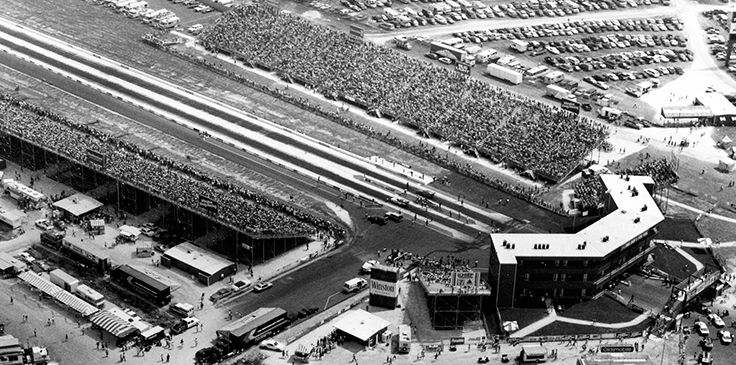
I’m not sure when the “ballpark track” phrase was coined, but I remember Gardner saying that our tracks should be like Major League Baseball stadiums. It only took a few years for that dream to begin to be realized with the opening of Texas Motorplex, which laid out the blueprint for so many tracks that have followed.
The schedule: In 1982, there were only 12 races on the national event schedule — Pomona, Gainesville, Atlanta, Baton Rouge, Columbus, Montreal, Englishtown, Denver, Brainerd (new that year), Indy, Fremont, and Orange County — plus the SPORTSnationals at the old Houston Int’l Dragway. (That SPORTSnationals happened on the week I joined, and it was rained out, giving me early insight on how NHRA handled rainouts. The schedule hovered in the mid- to high-teens for years until we cracked 20 events in 1997 with the addition of second races in Houston, Dallas, and Topeka, and by 2000, we had settled into the current 24-event season mode.

Television: As mentioned previously, NHRA had been on semi-regular TV since the early 1960s, albeit way time delayed. As the years rolled along and technology got better, so too did everything TV-related. When you go back and look at those old Diamond P-created/The Nashville Network shows that are all over YouTube, you can see how hard they worked to tell the story and just how good it was (RIP “Big Mac” and Steve Evans), but the camera on the phone in your pocket has better resolution than those old cameras did. Today, we live in a glorious world where video is in your pocket and on-demand. You can watch live coverage of the races anywhere via the NHRA.tv app, on NHRA social media channels, and on NHRA.com. I won’t say that Wally Parks never dreamed this would happen, but those of us who used to wait for weeks or even months to see actual footage of races we only read about in National Dragster can agree that these are amazing times for drag racing fans.
NHRA.com: Speaking of NHRA.com, can you imagine a time without the internet? I certainly can’t, but many of us lived that. If you were lucky, your local newspaper (remember those?) might print the final-round stats of some faraway national event that you could scour Monday morning, but otherwise, you had to wait for the monthly magazines to know who won in Columbus or Montreal. Now, thanks to the beauty of live timing, you can watch it all unfold, get full recaps of the day’s action, plus videos and photos. I’m proud to have created (with the help, prompting, and guidance of Division 1 bracket racer Michael Beard) what became NHRA.com back in 1995, beating even NASCAR to the digital punch.

Women in the NHRA: Women have been winning in the NHRA since the 1960s, with drivers like Carol Cox and Shirley Shahan, but, except for Shirley Muldowney and Angelle Sampey, victories by female racers were rare well into the 1990s. Just a month before I joined the team here, Lucille Lee had become just the second woman to win in an NHRA Pro category, and outside of Judy Lilly and Amy Faulk, no one did it with any kind of consistency. Over the last decade, the winner’s circle has been packed with race winners and world champions like Erica Enders, Brittany Force, Megan and Rachel Meyer, Jackie Fricke, and so many more.
THE PEOPLE
Living in a dynamic universe of legends, geniuses, can-doers, and Everyday Joes, over the span of four decades you meet A LOT of people who will change your world. Some you will work with, others will cross your path for their accomplishments or their bluster, and some will become friends that transcend how or when or why you met them.

Wally Parks: There have been a lot of people whom I admire, who have advised me, befriended, mentored, and even scolded me, but any conversation about People I Met at NHRA starts with Wally. I’ve written before about what he meant to the sport (and me!), about our dynamic, about his place in history. I’m blessed to have met him (many of my current co-workers can’t say the same thing), to have fallen into his good favor (usually), and to have been witness to the force that helped build the NHRA.

The legends: It’s no big secret that I grew up on Hot Wheels and that Don Prudhomme and Tom McEwen were my first drag racing idols. They were gods to me and my contemporaries, and to have even got the chance to meet them, let alone hang out with them, was a young kid’s dream. To have met them and earned their respect, trust, and friendship still seems unbelievable. Same for people like Don Garlits, Roland Leong, Shirley Muldowney, Richard Tharp, Raymond Beadle, and Bill Doner, whom I had read about as a young fan. I’ve met so many of my heroes because of this job, and almost to a person, they’ve been gracious and amazing.
The NHRA family: Of course, Wally didn’t do it all himself. By the time I first met him, he was already older than I am now (which is kinda old), but he was surrounded by great people. In the 1980s, when I first joined up, you see the strength in the NHRA in the dedicated people that helped run things. Dallas Gardner. Steve Gibbs. Bill “Farmer” Dismuke. Bernie Partridge. Brian Tracy. Carl Olson. Buster Couch. It felt really good to be a part of something so big, even if I was just a tiny cog in the machine at the time.

John Force: I wasn’t around to see Babe Ruth in his glory days and not as hockey-obsessed as I am now to witness Wayne Gretzky destroy the NHL record books, but I did have a front-row seat to see John Force tear the NHRA history books asunder. He didn’t win his first race until I’d been here for five years, so I got to see the struggle, the turning point, and the glory. He's one of the most unique, passionate, and crazed people I’ve ever met in my life, and even all of these years later, I’m still excited each time his number comes up on caller ID, knowing that he may be asking for a favor or advice or just calling to say thank you. He’s special, and we’re so blessed to have him as our brightest light.

The racer friends: No matter how hard you try to remain objective as a reporter, you develop favorites. When you interview someone enough, and you build that trust and respect, and your interviews don’t feel like interviews anymore, just friendly chats where you might talk about kids instead of clutches, it just happens, and continues to happen even if they’re no longer active. I won't even try to list them all because I’d hate to leave someone out, but they know who they are.
The media friends: It’s real fashionable today to hate on their mainstream media (sometimes with good reason), but the loyal cadre of folks that dedicate their lives to covering our sport are (with a few exceptions) hardworking, dedicated, and passionate about our sport as John Force. People like Dave Densmore, Bob Wilber, Kelly Wade, Elon Werner, Rick Green, and Bobby Bennett have become treasured colleagues with whom I get to share space and good times in the media center at each event.
I was also blessed to have met and befriended some of the great photographers whose images I drooled over in magazines as a teenager, guys like Steve Reyes, Tim Marshall, Bob McClurg, Jon Asher, Jere Alhadeff, Don Gillespie, and our own amazing Leslie Lovett.
THE PLACES
Indy: Second only to “I’m going to get to meet Don Prudhomme and Don Garlits” was the wow factor of “I’m going to get to go to Indy,” which for a young Southern California kid was like a trip to heaven. I didn’t get to go to Indy in 1982 — missing Don Prudhomme’s stunning 5.63 and Gary Beck’s 5.48 — because Wally told me that there was an unwritten rule that no one gets to go to Indy in their first year. I was heartbroken (and realize now it was probably more budgetary).

My first trip to Indy came the following year, but not for the U.S. Nationals. NHRA had moved the SPORTSnationals there, and even though I felt that jolt of excitement stepping onto hallowed ground, it wasn’t the same (pictured with the late Eric Brooks, my traveling roommate Chris Hawley, and the late Leslie Lovett). The Parks Tower was under construction on the starting line, so the famed Hurst crossover bridge had been dismantled to make way for it. I finally got the full Indy experience that September, and I have been to every U.S. Nationals since.
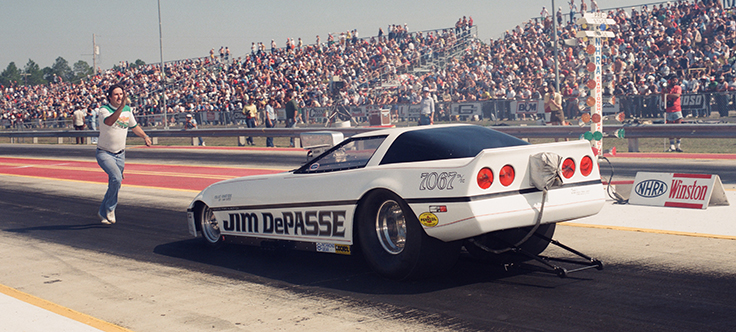
Gainesville: Like Indy, a track with so much lore, the Gatornationals being another race with such a history of amazing moments. My first trip to Gainesville came not on the NHRA dime but as a crewmember for Top Alcohol Funny Car racer Jim DePasse for a story for ND. I rode with the team from Southern California to Florida — another eye-opener — and although the trek was long and arduous, the payoff was well worth it. I got to back up a race car and walk around with a rag stuffed in my back pocket — just like the real crewguys!
Englishtown: Another historic track on any bucket list. Having read for decades about Englishtown match races, it was a thrill to be there, especially when – for a long while – it was the only event that held night qualifying.

And, as a longtime Bruce Springsteen fan, the chance to visit his hometown of Freehold, N.J., to cruise down “Born to Run’s” Highway 9, and visit Asbury Park to see the Stone Pony where he cut his performance teeth and Madam Marie’s (made famous in his song “Sandy”) made it all too amazing.
Columbus: Another of the OG national event tracks, perhaps best known for its short shutoff area. I spent many a day down there shooting photos of cars and drivers in great distress.

The 1983 Springnationals was the first true Pro national event I traveled to (I had worked the ’82 Finals at OCIR, but that was a “home race”) and began to get my education from Lovett on how to travel and meet and befriend racers.
Montreal: Traveling to Sanair Int'l Dragstrip in the little town of St. Pie in French-speaking Quebec was like taking a journey to another planet. Then and still the only NHRA national event to be hosted outside of the United States, I was enthralled by the venue, which had open-air fruit markets (and way too many male spectators in Speedos), the weirdest-looking timing tower, and the spaceship-like home to the track owner that resided past the finish line.

It's also the only national event where I ended up in the hospital, taking a stitch-requiring gash to my eyebrow after fellow staffer Bill Crites accidentally cocked me with his follow-through during a game of racquetball.

Bristol: The legend of “Thunder Valley” had echoed in my ears for decades. How could this possibly be true, that the roar of nitro engines could echo down a dragstrip? Beyond the legendary status of the track (dating back to the NHRA Springnationals in 1965), the “thunder” is what I came for (with Jerry Foss and Teresa Long), and the thunder is what I got. What an amazing venue.
UNFORGETTABLE MOMENTS
Learning the history of drag racing as laid out in magazines is one thing, but witnessing the history yourself and being able, years later, to say “I was there” are two different things. I used to be surprised that Don Prudhomme couldn’t remember every specific thing about every race he attended — especially some nuanced piece of trivia that stuck in my brain — but after attending hundreds of national events, they do all kind of blur together. When I joined the NHRA, they were preparing for the Cajun Nationals, Race 150 in its history, and here we are at race 1,009 next weekend in Epping, so unless you’ve got the ticket stub or credential or a photo, sometimes you forget if you were really there, but there are exceptions. Here are a few that resonate in my memory.

“Big Daddy’s” back (1984): When I got hired to work at National Dragster, one of the first thoughts was “I’m going to get to meet Don Garlits!” Well, unfortunately for me, other than his appearance earlier in 1982 at the Gatornationals, Garlits didn’t run an NHRA event until 1984 and even then seemed a shadow of himself. Then, of course, came the 1984 U.S. Nationals. His longtime buddy Art Malone helped him get some newer parts and pieces and the rest is history. Top Fuel was really struggling in 1984, plagued by small fields and reeling from the crashes of Doug Kerhulas and Shirley Muldowney (see below), and IHRA would eventually eliminate Top Fuel from its races for a time. Garlits’ win in Indy and at a subsequent (and rare) eight-car match race at Firebird Int’l Raceway and the creation of the Top Fuel Classic bonus event resurrected the class.

Shirley’s crash (1984): Man, I remember it like it was yesterday. Montreal 1984. I was standing next to Top Fuel great Gary Beck alongside the fencing that separates crowd from the racetrack, watching Top Fuel qualifying when her car made a terrifying sharp left turn off the track, disappeared from view into a drainage ditch, and all we saw were parts flying through the air and the engine, still running on whatever fuel remained in the lines while in midair. Watching her recovery and courageous comeback is something I’ll always cherish.
Force’s first win (1987): As it was with Shirley, I also witnessed John Force’s comeback from his terrible 2007 crash in Dallas, but his first career win, at the 1987 Grandnational, is the other great Montreal memory. To say that I’ve borne witness to all 155 of his wins in one way or another helps me mentally complete the transition from wannabe hero to GOAT.
Schumacher’s domination (2008): I was a fan and not a reporter when Don Prudhomme won at will in 1975 and ’76, but I was there in the trenches watching Tony Schumacher win seven straight races (and 15 of 24) in 2008 or Greg Anderson (15 of 23) in Pro Stock in 2004. I never thought we’d see that kind of domination in the parity-rich modern era.
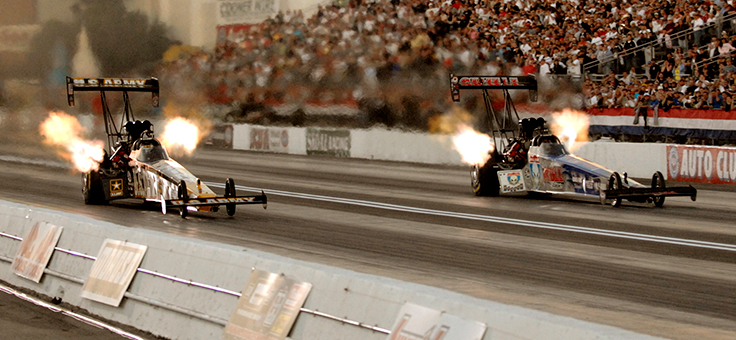
The Run (2006): Schumacher came into the NHRA Finals trailing Doug Kalitta in the points and needing a Hail Mary to pass him. Even after Kalitta lost early, Schumacher came into the final round needing not only to beat opponent Melanie Troxel but also reset his own national record for an extra 20 points. Back then, NHRA had the 1% rule, meaning that a driver had to make two runs within 1% of the other to make it a record.
The national record was 4.437, and his second-round pass of 4.475 would back up a run from anywhere between 4.436 to 4.427, but there was the very real possibility he could win the final with the quickest run in history and run too quick to have a backup and lose the championship despite winning the race.
The mathematical probabilities of hitting that .009-second sweet spot were like trying to drop a golf ball off a 50-story building into a water cup, but tuner Alan Johnson threaded the needle to a 4.428 to win the championship. One of the most amazing sporting moments I’ve ever seen.
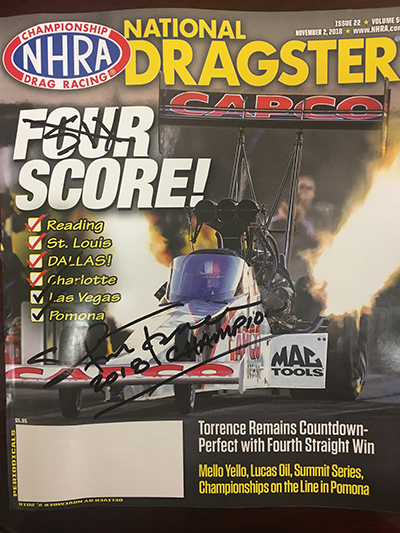
Torrence Countdown sweep (2018): Sure, Schumacher won seven straight in 2008, but Torrence’s six straight wins to cap his first championship were otherworldly. No one had ever even come close to sweeping the six Countdown to the Championship events until Torrence did it under all of the pressure that the playoffs entail.
I have a great piece of memorabilia from that time, the National Dragster cover we had made after his fourth win. It had checkboxes down one side, with the last two (Las Vegas and Pomona) left blank. He was on the cover, and it was the “souvenir issue” handed out in Pomona.
By the time we got to Pomona, he’d already won in Las Vegas, and after he defeated Tony Schumacher in the Pomona final, I handed him the magazine, he checked the last two boxes with his Sharpie and autographed it.
ON A MORE PERSONAL NOTE
The Pandemic (2020): No one could have predicted the COVID-19 pandemic that brought us to an unprecedented standstill in March 2020, and while that whole year (and even up to now) has been a mixed bag of emotions, I am so incredibly proud of the way everyone handled it. The work that an NHRA task force did to quickly get their hands around protocols for a safe return to racing and the support and cooperation of the racing community all made that happen. Even though it’s a largely negative memory, it’s one that I will always remember and cherish if for nothing more than the spirit of community it created.

National Dragster through the years: Obviously, this is why I came here — to write about the sport I’d loved for years — but I had no idea of the kind of friendships that I’d form, the camaraderie that I’d share, and the deep satisfaction I’d gain by joining the team. The early mentorship and support of industry veterans (and bosses) Neil Britt and “Mean John” Raffa, from Adriane Pierson, and today through Brad Gerber and David Kennedy, have allowed me to follow the visions I’ve had.
I’ve been surrounded by incredibly talented and dedicated people, from the writers to the photographers to the production team. Impossible deadlines and pressure meant nothing to them, and we never missed an issue. There have been more than 2,700 issues of National Dragster produced and nearly 1,700 of them have rolled off the presses under my watch.
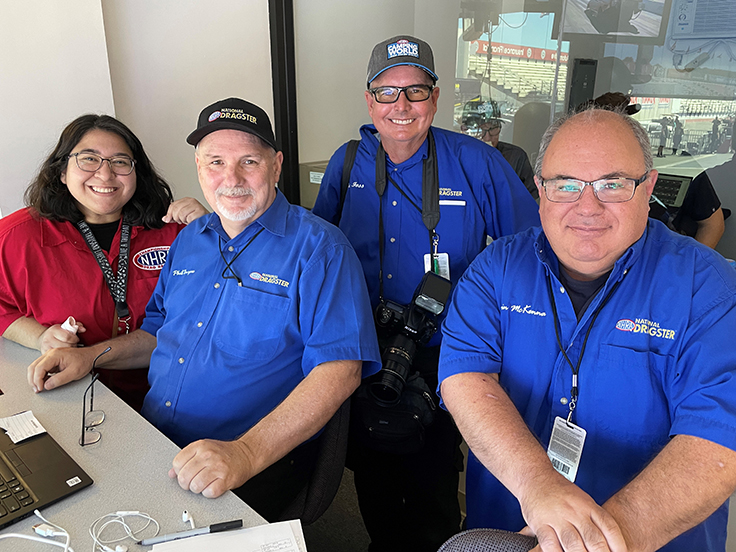
People like my right-hand man and great friend Kevin McKenna, Photo Editor Jerry Foss, Jeff and Robyn Morton, and production artists Jeff Mellem and Rey Oruga have been a tight unit for more than 20 years (and, along with Dominque Diaz and Natalia Naduris-Weissman) are part of today’s small but mighty team, and before them, people like Leslie Lovett, Teresa Long, Matt Hurd, Todd Veney, Marc Gewertz, Bill Crites, Chris Martin, George Phillips, and so many more helped make my job easier and my life better.

This column: And last, but so very far from least, there’s this humble little column. I started it almost 15 years ago, kind of on a whim, and while it took a few columns for me to find my footing and my target audience and my writing niche, I found it. The opportunity to honor our sport’s history from a fresh perspective, to tell “the stories behind the stories,” has been an honor and a privilege.
It's allowed me the space to pursue all of the backstories I always wondered about from the outside and to meet and be embraced by many legends of our sport. Todd Veney once told me that beyond all of my work at National Dragster, this column would define my legacy in the sport. I didn’t really get it at the time, but I feel he may have nailed it. The seminal piece, Dry Hops in Heaven, remains one of my most requested columns, even though it’s just one of more than 800 and was written way back in 2008 following the death of Scott Kalitta.
Writing this column has allowed me to interact with and get to know and befriend some of the great heroes of our sport like “the Snake” and “the Mongoose” and “the Ace,” John Wiebe, Jeb Allen, “Big Daddy,” Roland Leong, Richard Tharp, Marvin Graham, and so many more. (And to sit in Don Prudhomme's Hot Wheels Cuda!) It’s allowed me to interact with great historians like Bret Kepner, Dave Wallace, Bob Frey, and Jim Hill to get the stories right and deep, but just as importantly, it opened up a dialogue between me and every hardcore drag racing fan out there who lived my life, who pasted photos on their bedroom wall, who read the magazines, who mustered up the courage to talk to their heroes, who found happiness and meaning in a blown nitro engine.

It's been a great ride, and I promise you it’s far from over. This is Insider column No. 829, and I plan to get to 1,000 or more and, health and the economy permitting, I’d like to be around for a 50th anniversary at NHRA. Wally had 56 years of NHRA tenure, and I’ll likely never get there, but I’d be happy to be No. 2 behind the boss.
Thanks for all of your support, love, and assistance.
Phil Burgess can be reached at pburgess@nhra.com
Hundreds of more articles like this can be found in the DRAGSTER INSIDER COLUMN ARCHIVE
Or try the Random Dragster Insider story generator



















































